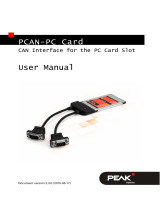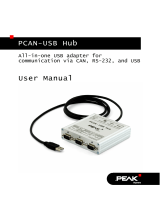
PCAN-USB – User Manual
10
3.2 Voltage Supply of External Devices
External devices with low power consumption (e.g. bus converters)
can be directly supplied via the CAN connector. With a solder bridge
for the one CAN channel on the PCAN-USB board (casing opened),
a 5-Volt supply can optionally be routed to pin 1 and/or pin 9 of the
D-Sub connector (for PCAN-USB opto-decoupled to S/N 199999 only
pin 1 available).
The opto-decoupled model of the adapter contains an intercon-
nected DC/DC converter. Therefore, the current output is limited to
50 mA.
Risk of short circuit! The 5-Volt supply is not protected sepa-
rately. Therefore, turn off the computer before you connect and
disconnect CAN cables or peripheral systems.
Consider that some computers still supply the USB ports with
power even when they are turned off (standby operation).
Do the following to activate the voltage supply:
Risk of short circuit! Solder with great care to avoid unwanted
short circuits on the card.
Attention! Electrostatic discharge (ESD) can damage or destroy
components on the circuit board. Take precautions to avoid
ESD while handling the circuit board.
1. Open the adapter casing. Push the latches on both sides
cautiously, e.g. with a flat tip screwdriver.
2. Remove the circuit board.
3. Set the solder bridge according to the model of the PCAN-
USB on the intended position on the circuit board (see
figures and table below).






















